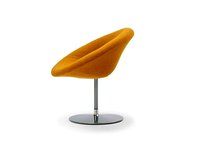The Vistosi tradition
is revived, in the name
of Guglielmo
When in the mid ‘40s Guglielmo opened a
new glasshouse in Murano, the Gazzabin-
Vistosi family had long been absent from
the roster of families who shared the art of
blown glass. The crisis in the year 1800
had decimated this line of glassmasters
which for half a century had produced key
figures in Murano glass Art. It took more
than a century and three generations to ful-
ly recover their position within the élite of
the Venetian glass world.
On May 7 1900, Domenico Vistosi wed
Egilda Toso: the following year she bore
the first of their sons, Guglielmo, who in
1945 would solemnly reinstate the Vistosi
name at the forefront of Murano glass art.
Bolstered by a favorable historical and eco-
nomic trend, Guglielmo’s company was
successful and revived the style and the
skill which had secured the family’s posi-
tion in the history of glass.
When he died in 1952, the company was
inherited by his brother Oreste who chose
to manage sales and marketing, and his
nephews Gino and Luciano who ran pro-
duction, which mainly consisted of glass
lighting articles.
The new philosophy:
to sell a “name” in glass
The Vetreria Vistosi’s company philosophy
matured through the ‘50s to a truly innova-
tive position. The trips to Northern
Europe, the stimuli and ideas derived
from contact with avant-garde artists,
foremost among them their friend
Alessandro Pianon, generated a totally
new company philosophy. In 1960, their
modern conception of production led to
the creation of a series of products,
lamps and objects characterized by ex-
tremely linear forms.
The “classic” production of glass and its
obsolete marketing channels were swept
away by a new policy: to present and sell
a “name” in glass, which can be recognized
in the refined shapes of pieces carefully
studied and created by designers.
For centuries the glassmasters had been
used to considering themselves the only
artists to possess the ability to create
glass. Thus they were reticent to make
things “on commission” that were de-
signed by someone else and ready for
production.
Once this natural hostility was overcome,
the strategy adopted by the Vistosi fami-
ly proved to be not only succesful, but
revolutionary for the company.
During the ‘60s, the glasshouse commis-
sioned works from artists of the caliber of
Gae Aulenti and Eleonore Peduzzi Riva.
This last great artist led the company
from its early efforts at renewal to full
maturity in the collaboration with the
most representative international archi-
tects of the moment such as Gae Aulenti,
Vico Magistretti, Angelo Mangiarotti,
Alberto Meda, Ettore Sottsass, Adalberto
dal Lago and many others.
The success of timeless
creations
At the end of the ‘70s, the company
changed hands: the uncle Oreste left the
company in 1977, his son Gino left in
1980. Luciano Vistosi found himself in the
position of seeking new partners for the
company.
One solution he considered was to sell
stock in the company, dividing the capital
into three equal parts: one would remain in
his possession, as head of production in
Murano, the second would go to Artemide
Spa from Milan, the third to the Swiss
bank Weiss Credit.
In the economic boom of the early ‘80s,
this new structure proved to be functional
and productive. The business was stimulat-
ed by the collaboration with designers, sup-
ported by a growing sales network.
In those years it reached the apex of its
artistic evolution, creating works which are
still part of museum collections all over the
world, some of which are still in production
today, because they are children of a
“timeless” beauty.
In 1982 the bankruptcy of Weiss Credit
brought economic difficulty to the compa-
ny. Two thirds of the glasshouse, the stock
owned by the bank and by Artemide, were
bought by Piero Toso from the Muranese
company Barovier & Toso, and soon resold
to the Fontana Arte group in Milan.
The contrasts between Luciano Vistosi and
his new partners led to a rapid and defini-
tive break in 1984, when Luciano left
Vistosi S.p.a. As a result, Vistosi S.p.a.’s
Risorge la tradizione Vistosi,
nel nome di Guglielmo
Quando alla metà degli anni ’40, Guglielmo
aprì una nuova vetreria a Murano, i
Gazzabin-Vistosi dei quali egli era erede,
già da molti anni non appartenevano più al
novero delle famiglie detentrici dell’arte su-
prema del vetro soffiato.
Con la crisi di settore nel 1800, il ceppo di
vetrai che da mezzo secolo generava per-
sonalità di spicco nell’Arte muranese, aveva
visto il declino delle proprie sorti. Ci vollero
quasi un secolo intero e ben tre generazio-
ni per rientrare a pieno titolo nell’élite della
vetraria veneziana.
Domenico Vistosi, il 7 maggio 1900 porta-
va all’altare Egilda Toso: l’anno seguente
nacque il primo dei loro sei figli, quel
Guglielmo che nel 1945 riconsegnò solen-
nemente il nome dei Vistosi al mondo del
vetro di Murano.
L’impresa di Guglielmo, favorita anche da
una positiva congiuntura storico-economi-
ca, ebbe successo e riportò sul mercato lo
stile e la maestria che avevano reso in-
delebile il nome della famiglia nella sto-
ria del vetro.
Alla sua morte nel 1952, la proprietà del-
l’azienda venne divisa tra il fratello
Oreste, che scelse di occuparsi dell’atti-
vità commerciale e i nipoti Gino e Luciano
che si dedicarono alla produzione, incen-
trata principalmente su articoli vetrari per
l’illuminazione.
La nuova filosofia:
vendere una “firma”
del vetro
La politica aziendale della Vetreria Vistosi
maturata nel corso degli anni ’50 approdò
a posizioni decisamente innovative.
I viaggi nei paesi del Nord Europa, gli sti-
moli e le idee derivanti da molteplici con-
tatti con artisti all’avanguardia e nomi di
vaglia, primo tra tutti l’amico Alessandro
Pianon, diedero vita ad una filosofia azien-
dale completamente nuova.
Una moderna concezione della produzione
sfociò nel 1960 in una serie di prodotti,
lampade e oggetti dalle forme estrema-
mente lineari.
La produzione “classica” di vetri e la loro
commercializzazione attraverso politiche
di diffusione ormai vecchie e inadeguate,
furono soppiantati dalla nuova ottica:
proporre e vendere una “firma” del ve-
tro, riconoscibile nelle forme raffinate dei
pezzi che prendevano vita sul tavolo dei
designers, generate da studi e progetti
accurati.
Superata la naturale ostilità dei maestri
vetrai, abituati da secoli ad essere gli uni-
ci artisti nei quali s’incarnava il fulcro del-
Vistosi e Moretti
il passato e il presente del Vetro
Vistosi and Moretti
the past and present of glass
36
Piatto in vetro soffiato, Luciano Vistosi
Blown glass plate, Luciano Vistosi







